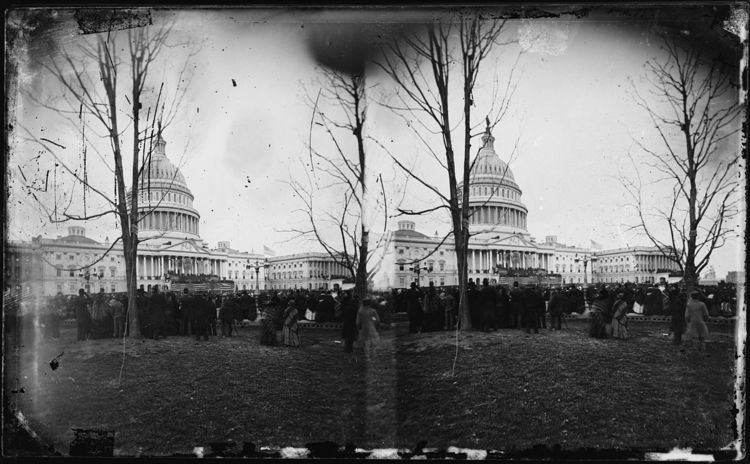The Fortieth United States Congress was a meeting of the legislative branch of the United States federal government, consisting of the United States Senate and the United States House of Representatives. It met in Washington, D.C. from March 4, 1867 to March 4, 1869, during the third and fourth years of Andrew Johnson's U.S. Presidency. The apportionment of seats in the House of Representatives was based on the Eighth Census of the United States in 1860. Both chambers had a Republican majority.
March 30, 1867: Alaska Purchase
February 24, 1868: Impeachment of Andrew Johnson
May 16, 1868: President Johnson acquitted
May 26, 1868: President Johnson acquitted again
November 3, 1868: 1868 presidential election: Ulysses S. Grant (R) defeated Horatio Seymour (D)
December 25, 1868: President Johnson granted unconditional pardons to all Civil War rebels
January 20, 1869: Elizabeth Cady Stanton was the first woman to testify before Congress
Four Military Reconstruction Acts, continued:
March 2, 1867, ch. 153, 14 Stat. 428
March 23, 1867, ch. 6, 15 Stat. 2
July 19, 1867, ch. 30, 15 Stat. 14
March 11, 1868, ch. 25, 15 Stat. 41
July 27, 1868: Expatriation Act of 1868, ch. 249, 15 Stat. 223
July 28, 1868: Fourteenth Amendment ratified
February 26, 1869: Fifteenth Amendment passed by Congress with a Senate vote of 39 Republican votes of "Yea", 8 Democrat & 5 Republican votes of "Nay" and with 13 Republican & 1 Democrat not voting. The House of Representatives had already passed the amendment on February 25, 1869 with 143 Republican & 1 Conservative Republican votes of "Yea", 39 Democrat, 3 Republican, 1 Independent Republican & 1 Conservative votes of "Nay" and with 26 Republican, 8 Democrat & 1 Independent Republican not voting. Following congressional approval the proposed amendment was then sent by Secretary of State William Henry Seward to the states for ratification or rejection.
February 16, 1868: Treaty of Fort Laramie (1868) ratified
April 29, 1868: Treaty of Fort Laramie (1868), 15 Stat. 635, signed
July 25, 1868: Wyoming Territory organized
The count below identifies party affiliations at the beginning of the first session of this Congress, and includes members from vacancies and newly admitted states, when they were first seated. Changes resulting from subsequent replacements are shown below in the "Changes in membership" section.
During this Congress, Arkansas, Florida, Alabama, North Carolina, Louisiana, and South Carolina were readmitted to representation in both the Senate and the House. Georgia was readmitted with representation in the House only.
President: Vacant
President pro tempore: Benjamin Wade (R)
Republican Conference Chairman: Henry B. Anthony
Democratic Campaign Committee Chairman: James Rood Doolittle
Speaker: Schuyler Colfax (R), until March 3, 1869
Theodore M. Pomeroy (R), elected March 3, 1869. Served for 1 day.
This list is arranged by chamber, then by state. Senators are listed in order of seniority, and Representatives are listed by district.
Senators were elected by the state legislatures every two years, with one-third beginning new six-year terms with each Congress. Preceding the names in the list below are Senate class numbers, which indicate the cycle of their election. In this Congress, Class 1 meant their term ended with this Congress, requiring reelection in 1868; Class 2 meant their term began in the last Congress, requiring reelection in 1870; and Class 3 meant their term began in this Congress, requiring reelection in 1872.
Skip to House of Representatives, below
The names of members of the House of Representatives are preceded by their district numbers.
The count below reflects changes from the beginning of the first session of this Congress.
replacements: 3
Democratic: 0 seat net loss
Republican: 0 seat net gain
deaths: 1
resignations: 2
interim appointments: 1
seats from newly re-admitted states: 12
Total seats with changes: 16
replacements: 10
Democratic: 2 seat net loss
Republican: 0 seat net gain
Independent Republican: 1 seat net gain
Conservative: 0 seat net gain
deaths: 8
resignations: 3
contested election: 3
seats from re-admitted states: 32
Total seats with changes: 44
Lists of committees and their party leaders.
Agriculture
Appropriations
Audit and Control the Contingent Expenses of the Senate
Claims
Commerce
Distributing Public Revenue Among the States (Select)
District of Columbia
Education
Finance
Foreign Relations
Impeachment of President Andrew Johnson (Select)
Impeachment Trial Investigation (Select)
Indian Affairs
Judiciary
Manufactures
Military Affairs
Mines and Mining
Naval Affairs
Ninth Census (Select)
Ordnance and War Ships (Select)
Pacific Railroad
Patents and the Patent Office
Pensions
Post Office and Post Roads
Private Land Claims
Public Lands
Representative Reform (Select)
Retrenchment
Revolutionary Claims
Rules
Tariff Regulation (Select)
Territories
Treasury Printing Bureau (Select)
Whole
Accounts
Agriculture
Appropriations
Banking and Currency
Claims
Coinage, Weights and Measures
Commerce
District of Columbia
Education and Labor
Elections
Expenditures in the Interior Department
Expenditures in the Navy Department
Expenditures in the Post Office Department
Expenditures in the State Department
Expenditures in the Treasury Department
Expenditures in the War Department
Expenditures on Public Buildings
Freedmen's Affairs
Foreign Affairs
Indian Affairs
Invalid Pensions
Manufactures
Mileage
Military Affairs
Militia
Mines and Mining
Naval Affairs
Pacific Railroads
Patents
Post Office and Post Roads
Public Buildings and Grounds
Public Expenditures
Public Lands
Revisal and Unfinished Business
Revolutionary Claims
Roads and Canals
Rules (Select)
Standards of Official Conduct
Territories
Ways and Means
Whole
Conditions of Indian Tribes (Special)
Enrolled Bills
Ordnance (Select)
Reorganize the Civil Service in the Departments
Retrenchment
Revise and Equalize the Pay of the Employees of Each House
To Examine the Accounts for Repairs and Furnishing of the Executive Mansion
Architect of the Capitol: Edward Clark, appointed August 30, 1865
Librarian of Congress: Ainsworth Rand Spofford
Chaplain of the Senate: Edgar H. Gray (Baptist)
Secretary of the Senate: John W. Forney
George C. Gorham, elected June 4, 1868
Sergeant at Arms of the Senate: George T. Brown
Chaplain of the House: Charles B. Boynton (Congregationalist)
Clerk of the House: Edward McPherson
Doorkeeper of the House: Charles E. Lippincott
Messenger to the Speaker: William D. Todd
Postmaster of the House: William S. King
Sergeant at Arms of the House: Nehemiah G. Ordway

